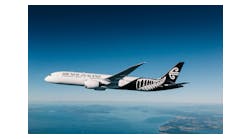While the Farnborough Air Show is typically a show case for the Airbus and Boeing duopoly, regional aircraft and small narrow bodies from other manufacturers are no longer the footnote that was once the case.
The principal regional aircraft manufacturers secured firm orders for some 100 aircraft during the show. In addition, a similar number of options were also booked with ATR alone collecting some 75 for its turboprops. Embraer and Bombardier agreed memorandums of understanding for more than 200 E-2 and C-Series jets and Mitsubishi had its piece of the action with MOUs for over 40 aircraft.
Turboprops
ATR continues its lead over the Bombardier Q Series with substantial orders placed by NAC and Avianca. The NAC order is highly significant not only because of its size, 25 firm and 50 options, but because it represents the first major order for the smaller ATR42-600 and, for the first time, a leasing company has placed the majority of turboprop orders at any air show. ALC has also ordered an additional seven ATR72-600s. Other firm orders included 6 for Mayanma Air and 10 for Avianca.
The Bombardier Dash 8 Q400 performed less strongly with only 5 firm orders and an MOU for a further 5 from Falcon Aviation Services, but an order for two additional Q400s from NOK Air so soon after the previous order suggests that its new 86 seat variant may be achieving some traction in the market.
The “Case for investing in Regional Aircraft” report prepared by ALTAÏR on behalf of the European Regions Airline Association (ERA) identified that some 26% of regional aircraft were financed by leasing companies (see Fig 31 Page 37), but based on the new orders for turboprops alone, this proportion will change dramatically over the years to come and follow the trend towards increased leasing activity that is already evident for larger aircraft. However, such a reliance on Lessors is not without certain risks. Not only does the predominance of NAC in ATR’s order book mean that delivery positions for new operators or indeed other lessors are difficult to secure before 2017, but also a single dominant customer is rarely in any manufacturer’s long-term interests. To an extent, its ability to sell aircraft to new operators becomes limited and it may even find itself competing with NAC to place new units.
Conversely, this order also represents a new vote of confidence in 50 seat turboprops for which no significant orders, save incremental units, have been placed in this decade. The current population of 50 seat turboprops is ageing and needs replacement. Many operators of this capacity of aircraft are unable to purchase outright, so a leasing option can only be good news.
Regional jets & small narrow bodies
The relative lack of demand for current generation regional jets at Farnborough and orders for new generation aircraft continues to show how this segment is evolving towards larger types, which are increasingly referred to as small narrow bodies. Only Mitsubishi’s forthcoming MRJ is described as a regional jet. The MRJ secured 6 firm orders from Air Mandalay and an MOU for 40 from Eastern. This reinforces the dominance of North America and the Far East for regional jet orders that is shown in Fig 24 of the ERA report.
Small orders for current generation E-jets were placed by Fuji Air, Azerbaijan Air and 20 were announced for Tianjin, but the majority of small jet commitments were placed for the forthcoming Embraer E2 series and Bombardier’s C-Series. Apart from a firm order for 10 E190 E2 and a further 10 options, all other E-jet announcements were based on MOUs. This included a massive 100 E175 E2 commitment by Trans States and 50 by Azul for the larger E190 E2 variant.
Bombardier also made progress with commitments for its forthcoming C-Series. Despite its delayed launch, MOUs were signed for 66 CS100 and its larger sibling the CS300. This includes a substantial commitment from Falko Regional Aircraft for 24 aircraft. Chinese operators also featured for Bombardier with Zheijang Loong Airlines committing to 20 CS100s. Unusually for a new aircraft type, Lessors have featured strongly in the initial backlog for C-Series aircraft. Falko’s entry represents the third Lessor for the type. Despite continuing scepticism about Bombardier’s ability to compete with the lower end of the Boeing and Airbus product lines, such Lessor confidence bodes well for the future.
Emerging themes from Farnborough 2014
While regional aircraft sales may be less than those of Airbus and Boeing, the number of regional aircraft orders is also on an upward trajectory. Demand is strongest for current generation fuel efficient turboprops and small narrow body aircraft upwards of 90 seats. With continued high fuel costs, this trend is unlikely to change any time soon. In parallel the world’s dominant regional aircraft Lessor has recognised the need to replace the world’s ageing fleet of 50 seat aircraft. Many routes either do not need or cannot make money with 90 seat aircraft.
From a financing perspective, the main trend to emerge is that Lessors are now taking a major interest in regional aircraft, but these are different names to those that are active in the mainstream narrow and wide body markets. With this in mind, the report “The case for Investing in Regional Aircraft” will be revised and updated later this year to account for this and other emerging trends. The next edition will also explore the secondary used market in greater detail as this was requested by several delegates at events where the report was presented earlier this year.




